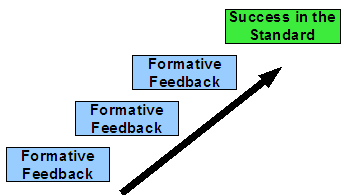
Formative marking is the buzz term of the decade but what does it actually look like in good practice? It’s taken me a long process of refinement to finally reach a point where I feel sure that my marking is truly formative and enables students to make the most progress in their learning. In the highly discursive subjects of English and Sociology, this truly matters.
I’ve come a long way from comments such as ‘You need to write in more detail’ and ‘Improve your spellings’ to where my marking is today. My marking of any extended piece of writing or essay centres on three rules:
1. Highlighting something very specific that the student has done well
2. Setting a first target for improvement that’s specific to the topic
3. Setting a second target for improvement that’s a transferable skill for future essays/extended writing, no matter what the topic.
For example, in recent feedback to a Year 12 Sociology student on an essay assessing government policies implemented to create an education market and raise standards, I set her two clear targets :
AO1 (knowledge and understanding of this specific topic): To include two more recent policies created to raise standards.
AO2 (interpretation, application, analysis and evaluation skills transferable to any essay topic): To ensure that each point of your argument is evaluated for both strengths and weaknesses where possible, and that evaluation occurs throughout your essay, not just at the end.
All this detailed formative marking is pointless unless we can cultivate a culture of redrafting and redoing; a climate where it is okay, and in fact beneficial, to make mistakes. I say to my older students ‘You will never do a piece of work for me just once unless you get full, or almost full, marks. You wouldn’t hand in a letter of application for a job after just writing what comes out of your head the first time, would you? You’d redraft it and let other people give you feedback on it before submitting it. Your work is the same.’ I repeat this mantra regularly to them to remind them of why we need these high expectations in our class.
Then comes the hard bit: if I’ve asked them to redraft/redo something then I commit to remarking it for them (as promptly as possible). Although that is hard going for me, in the long run it isn’t because it is what wins them over. When they can visibly see how their work improves from one draft to the next, they feel such a sense of success that it motivates them enormously.
Thankfully, I’ve reached a point where I don’t need to ask them to redraft anymore; they will do it of their own accord because they want to feel more success. For example, one of my students this year turned a corner for me; he recently redrafted an essay three times for me (more than I’d asked him to) moving his grade from an E to a B. He sustained a B grade in his next essay too, this time after just one redraft. All of last year he was working at an E/D grade.
There are also a host of ways in which I could make the marking quicker, for example, having a bank of statements ready for the second target (the transferable skill one) which I can select from and stick on their work. Or a feedback sheet which has a checklist of all the knowledge for that topic, as well as a list of the transferable skills, that I can tick/cross as appropriate. In fact, with my A level classes I have begun attaching a copy of the mark scheme for the essay question to the back of the essay, highlighting in green the areas they met and in orange the areas they didn’t. This, along with my written targets, gives them the clearest idea of how to improve in their redraft.
To build GRIT like this we need to start young. I have the exact same expectations of my Year 7 class; they know that I expect any extended piece of writing to be redrafted after a first marking. I’m hoping that by the time they get anywhere near their GCSEs, this climate will be embedded.
Finally, a culture of redrafting leads to GRIT in other aspects of the lesson because students know that your expectations of the standard of their work is very high and shoddy work will not be accepted. Also, if they can get top marks for a piece of work then they won’t have to redraft it! This climate extends to verbal responses too; not accepting a poor quality verbal answer from a student and being tenacious in digging further with questioning.
Daniel Coyle presents the concept of GRIT well in his book
The Talent Code:
“reaching and repeating, making mistakes, receiving feedback, building better brains…” is what leads to success, thus emphasising the importance of quality feedback that shows students exactly how to right their mistakes (and how it can become a springboard for tenacity in students’ learning). Despite living in a society that elevates immediate gratification and overnight celebrity status, I’m finally beginning to think that my students are embracing, and ingraining, the idea that it is the amount of determined effort they put into their work that will equal their success.
Click here for a great blog that further explores this concept within education.


